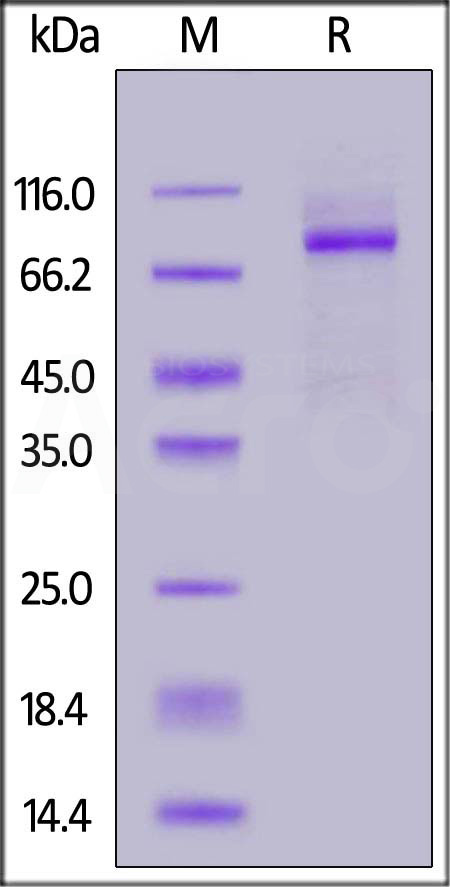分子别名(Synonym)
Secretory component, SC
表达区间及表达系统(Source)
Human Secretory Component, Twin Strep Tag (SCT-H5280) is expressed from human 293 cells (HEK293). It contains AA Lys 19 - Arg 603 (Accession # P01833-1).
Predicted N-terminus: Lys 19
Request for sequence
蛋白结构(Molecular Characterization)

This protein carries a twin strep tag at the C-terminus.
The protein has a calculated MW of 67.6 kDa. The protein migrates as 80-100 kDa under reducing (R) condition (SDS-PAGE) due to glycosylation.
内毒素(Endotoxin)
Less than 1.0 EU per μg by the LAL method.
纯度(Purity)
>90% as determined by SDS-PAGE.
制剂(Formulation)
Lyophilized from 0.22 μm filtered solution in PBS, pH7.3. Normally trehalose is added as protectant before lyophilization.
Contact us for customized product form or formulation.
重构方法(Reconstitution)
Please see Certificate of Analysis for specific instructions.
For best performance, we strongly recommend you to follow the reconstitution protocol provided in the CoA.
存储(Storage)
For long term storage, the product should be stored at lyophilized state at -20°C or lower.
Please avoid repeated freeze-thaw cycles.
This product is stable after storage at:
- -20°C to -70°C for 12 months in lyophilized state;
- -70°C for 3 months under sterile conditions after reconstitution.
电泳(SDS-PAGE)

Human Secretory Component, Twin Strep Tag on SDS-PAGE under reducing (R) condition. The gel was stained with Coomassie Blue. The purity of the protein is greater than 90%.
背景(Background)
The secretory component (SC) is a unique polypeptide chain that may be found in immunoglobulins A and M (IgA and IgM). The SC wraps around two IgA units joined by a J chain protein fragment, resulting in a configuration with each of the two antigen binding regions of the two constituent y-shaped antibodies exposed. One identified function of secretory components is to protect IgA antibodies from degradation by the gastric acids and enzymes of the digestive system. It also appears that SC may serve in the three-dimensional organization or in the transport and distribution of the resulting IgA complexes.






















































 膜杰作
膜杰作 Star Staining
Star Staining













